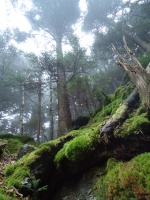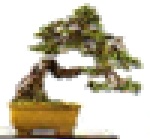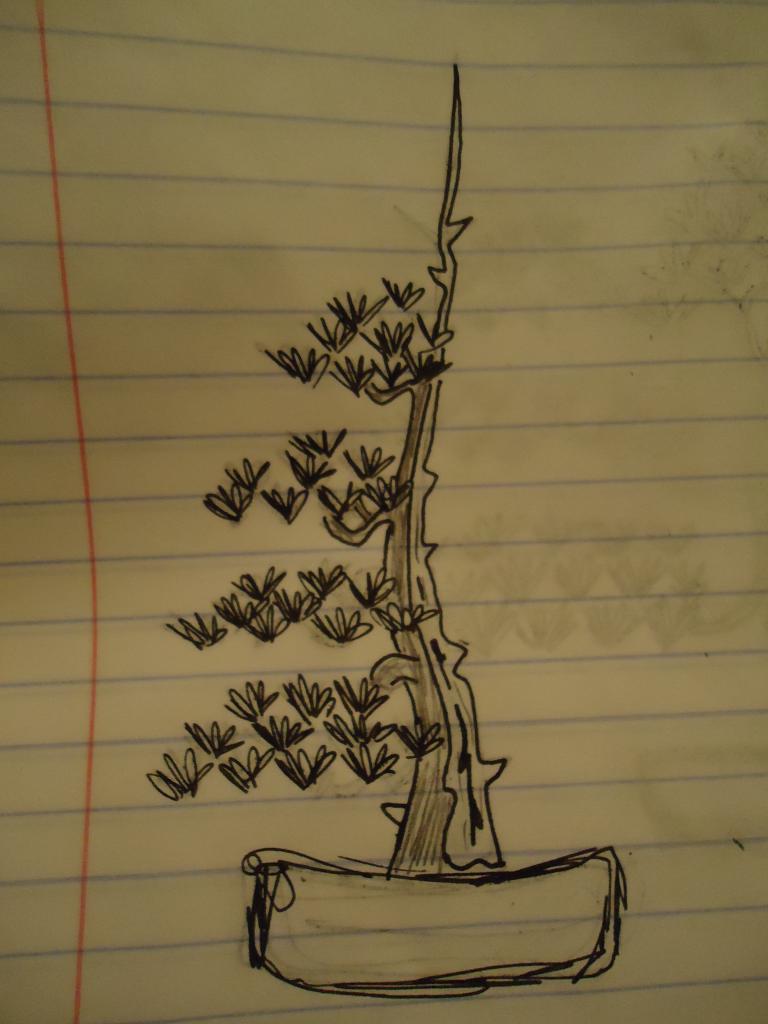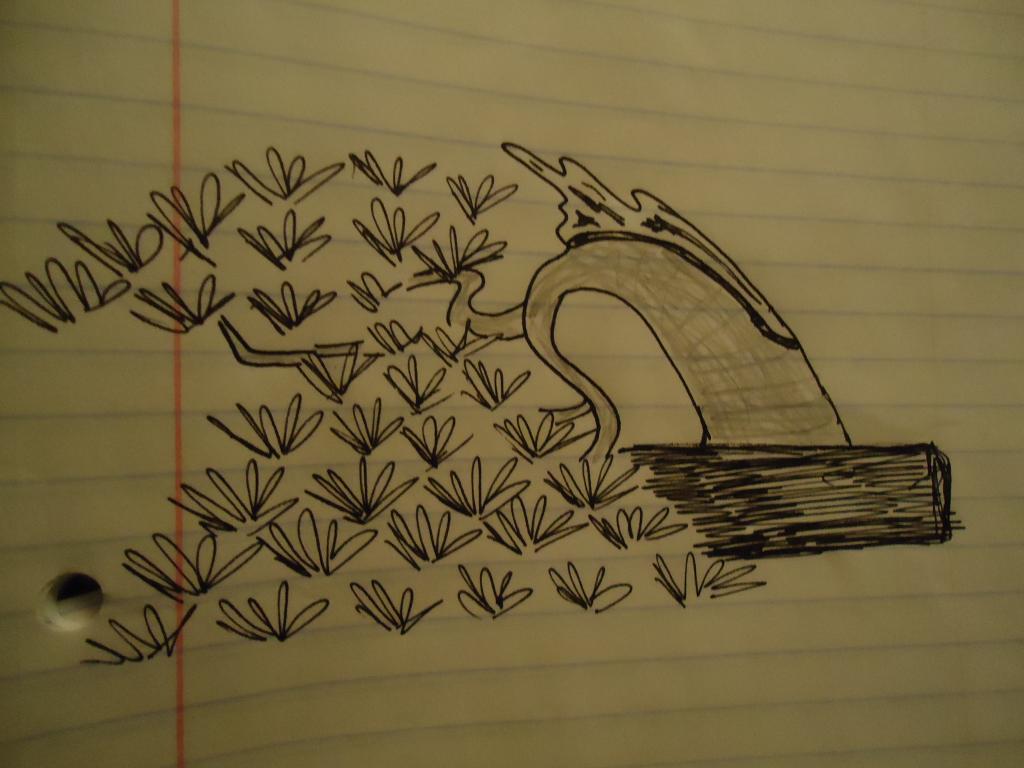a few japanese white pine Qs
+2
sunip
appalachianOwl
6 posters
Page 1 of 1
 a few japanese white pine Qs
a few japanese white pine Qs
After waiting a good bit to gain some knowledge/experience, have been looking for a jwp. All encountered on the intronet and a local nursery that had one, where ways out of my currency range. Found one today that spoke to me, was still more than have ever spent on a tree, but not at all outrageous compared to research. Had been feild grown and was in burlap, it had already been "insulted" for the season and its fall so didn’t want to mess with anything. Decided to place in a large pot, practically filled the thing with about 1" to 1/2" to spare. Removed the burlap as I thought this might get soggy over the winter, and filled the remaining space with pea gravel (about 2" of gravel under mass) for better drainage as the soil it is in is tight clay, i thought other soil around it might lead to winter drainage issues. This will be placed in the ground for the winter. My first question is simple, is this ok until spring? Second, some of the needles have yellowish tips; I know this is natural for some pines in colder months, or something else? Thanks all for reading and any info on the matter, have learned a great deal form this resource already- Jacob













appalachianOwl- Member
 Re: a few japanese white pine Qs
Re: a few japanese white pine Qs
Hopeing all's well since no one has  what have you done!!! Did find some info of a similar account. please close if nessisary, thanks any ways all
what have you done!!! Did find some info of a similar account. please close if nessisary, thanks any ways all
 what have you done!!! Did find some info of a similar account. please close if nessisary, thanks any ways all
what have you done!!! Did find some info of a similar account. please close if nessisary, thanks any ways all
appalachianOwl- Member
 Re: a few japanese white pine Qs
Re: a few japanese white pine Qs
Hello Jacob.
The yellow points on the needles could indicate converse osmosis due to a to wet rootball.
I do not know your climate conditions, but placement in a pot in the ground for the winter looks great to me.
However cheque on that clay ball, first of all it should get less wet, maybe you can make some holes in it with chopsticks for some air as well,
so the roots have a chance to breathe.
During rain; cover the pot, and cover the needles during continues freezing winds so they will not dry and burn.
The bigger granules around the rootball makes watering difficult because the water will flow around the ball and may not wet it,
so water control will be a bit difficult.
Looking at the picture the tree is grafted, this will need some attention in the future.
Do nothing until you repot it in spring but remove old brown needles now.
All clay has to be removed but personally i would not wash it off because the miccorhizzum culture on the roots would be gone to.
good luck with your tree,
Sunip
The yellow points on the needles could indicate converse osmosis due to a to wet rootball.
I do not know your climate conditions, but placement in a pot in the ground for the winter looks great to me.
However cheque on that clay ball, first of all it should get less wet, maybe you can make some holes in it with chopsticks for some air as well,
so the roots have a chance to breathe.
During rain; cover the pot, and cover the needles during continues freezing winds so they will not dry and burn.
The bigger granules around the rootball makes watering difficult because the water will flow around the ball and may not wet it,
so water control will be a bit difficult.
Looking at the picture the tree is grafted, this will need some attention in the future.
Do nothing until you repot it in spring but remove old brown needles now.
All clay has to be removed but personally i would not wash it off because the miccorhizzum culture on the roots would be gone to.
good luck with your tree,
Sunip
sunip- Member
 Re: a few japanese white pine Qs
Re: a few japanese white pine Qs
sunip wrote:All clay has to be removed but personally i would not wash it off because the miccorhizzum culture on the roots would be gone to.
Mycorrhiza primarily aids phosophorous assimilation. Loss of the culture can be addressed with fertilizer. However, I seriously doubt that there is any mycorrhiza in that muddy muck. Regardless, micorrhiza tend to not grow when there is ample phosporous in the soil. Over time a local culture will establish itself if there isn't too much phosphorous in the mix and the tree will be happy. If there is ample phosphorous, a culture may not develop but the tree will also be healthy anyway.
Had it been my tree, I would have kept the burlap wrapping and would have planted it shallowly (sometimes called heeled) for the winter. As long as the burlap stays damp, the mud is not dry. But, next spring do get rid of all that mud!

0soyoung- Member
 Re: a few japanese white pine Qs
Re: a few japanese white pine Qs
hi,
from the foliage it is plain to see the tree is strong and was doing very well as a landscape tree. it seems to be grafted onto a pine rootstock of some type but to adapt to life in a bonsai pot the solid ball of clay / mud will need removing for sure. I really doubt there is any benefitial fungi growth in that ball as it looks truely solid and the gravel surround you have used will stop winter waterlogging and potential root rot over the winter. In spring i'd soak the mud ball in a big bucket to soften it, then wash off all the mud with a water jet before assessing the roots and seeing what size pot it will go in....try not to prune any off this first time as much of the trees strength comes from the roots.
after the spring potting the tree needs to recover, candle out and start growing - once the new growth has hardened off in early Autumn it will be time
for the first styling
nice find, well done
Marcus
from the foliage it is plain to see the tree is strong and was doing very well as a landscape tree. it seems to be grafted onto a pine rootstock of some type but to adapt to life in a bonsai pot the solid ball of clay / mud will need removing for sure. I really doubt there is any benefitial fungi growth in that ball as it looks truely solid and the gravel surround you have used will stop winter waterlogging and potential root rot over the winter. In spring i'd soak the mud ball in a big bucket to soften it, then wash off all the mud with a water jet before assessing the roots and seeing what size pot it will go in....try not to prune any off this first time as much of the trees strength comes from the roots.
after the spring potting the tree needs to recover, candle out and start growing - once the new growth has hardened off in early Autumn it will be time
for the first styling
nice find, well done
Marcus

marcus watts- Member
 Re: a few japanese white pine Qs
Re: a few japanese white pine Qs
Thank you all for the info, have superb knowledge for the future as well as now! Have been studying this one the past few day for potential paths, noticed there is some pretty knarly inverse taper round the first branches had not picked up on earlier, so will have to get creative. Have attached some Vague ideas have been kicking around, really do like the first one, have been a fan of the style but no materials(as of yet). Seems most atainable rout to dealing with the taper and graft section to create a naturally harsh look. Second one kinda if nothing else workes all else fails, would still be a neat one. Got a while to think about it though, any other ideas out there???





appalachianOwl- Member
 Re: a few japanese white pine Qs
Re: a few japanese white pine Qs
I enjoyed your drawing and design. Here is a follow up question for the pros. I've heard the traditional advice to reduce the foliage in proportion to the inevitable removal of much of the root mass, while removing the clay, in order to maintain balance. I have also heard that that advise is bunk and that you should leave as many leaves and as much energy with the tree as possible? I would imagine the truth is species dependent, but would love to hear a few opinions on the matter.
Last edited by MrFancyPlants on Tue Nov 27, 2012 2:00 pm; edited 1 time in total (Reason for editing : Typo)

MrFancyPlants- Member
 Re: a few japanese white pine Qs
Re: a few japanese white pine Qs
Hello
I have no ideas on a design as it is maybe a bit early for the tree and the pictures show not enough
but it is nice and good dreaming and drawing.
I feel, while repotting, the nerbari is the first thing to look at, try to make a good root spread.
Later (after a growing season) branches on the same level have to be reduced to one branch
and some wiring to get movement in the trunk as it still maybe possible.
The rule with pines is -one thing at a time- (growing season) but young trees like this allow a bit more,
however the step from clay ball to a decent bonsai pot soil is a big one for a pine.
About the miccorhiza; there will be not much in that ball of cours, but you will be amazed at times.
Btw yellow needles tips can also be caused by shortage of potassium or magnesium.
I hope there are some sufficient drainage holes in that container.
Removing branches to get balance with a pruned rootball is species dependent but mostly done with deciduous trees.
Also conditions can be important.
Evergreens like Juniper are pruned a bit but Pines i do not prune back wile repotting,
however; wile digging or preparing yamadori you will have to cut sometimes to long branches,
important is to keep the roots as big as possible.
Misting the green needles after potting will help to maintain balance.
Sunip
I have no ideas on a design as it is maybe a bit early for the tree and the pictures show not enough
but it is nice and good dreaming and drawing.
I feel, while repotting, the nerbari is the first thing to look at, try to make a good root spread.
Later (after a growing season) branches on the same level have to be reduced to one branch
and some wiring to get movement in the trunk as it still maybe possible.
The rule with pines is -one thing at a time- (growing season) but young trees like this allow a bit more,
however the step from clay ball to a decent bonsai pot soil is a big one for a pine.
About the miccorhiza; there will be not much in that ball of cours, but you will be amazed at times.
Btw yellow needles tips can also be caused by shortage of potassium or magnesium.
I hope there are some sufficient drainage holes in that container.
Removing branches to get balance with a pruned rootball is species dependent but mostly done with deciduous trees.
Also conditions can be important.
Evergreens like Juniper are pruned a bit but Pines i do not prune back wile repotting,
however; wile digging or preparing yamadori you will have to cut sometimes to long branches,
important is to keep the roots as big as possible.
Misting the green needles after potting will help to maintain balance.
Sunip
sunip- Member
 Re: a few japanese white pine Qs
Re: a few japanese white pine Qs
I think you will have to be very careful with your watering. That clay looks almost impervious to water, and I suspect if you water from the top it will merely flow down the sides of the pot through the gravel and will not moisten that clay ball at all.

JimLewis- Member
 Re: a few japanese white pine Qs
Re: a few japanese white pine Qs
Thanks for concerns Jim, did as instructed and poked some holes trough the mass hopeing that would also help with watering. Made a sweet little glass water can that allows for a slow even distribution of water, very similar to rain. Think if i take time with it this will work? Thanks again Sinup for more info also.

appalachianOwl- Member
 Similar topics
Similar topics» Pine cones on Japanese White Pine. Should they be removed?
» japanese white pine
» Japanese White Pine
» Japanese White Pine
» JWP Questions
» japanese white pine
» Japanese White Pine
» Japanese White Pine
» JWP Questions
Page 1 of 1
Permissions in this forum:
You cannot reply to topics in this forum






